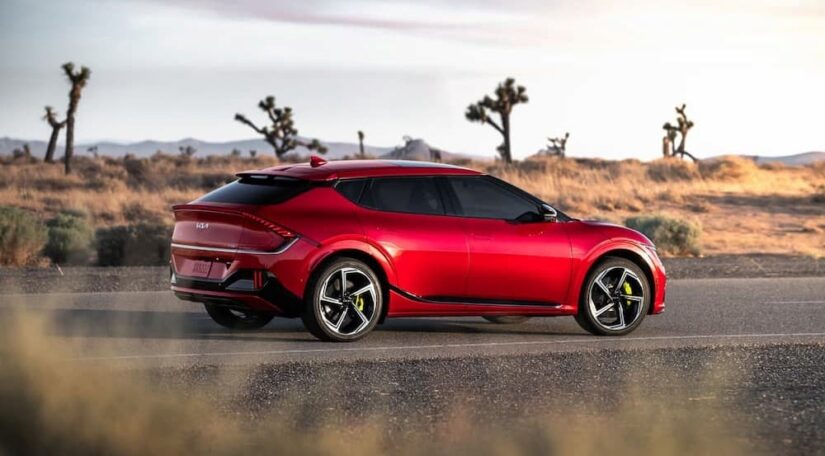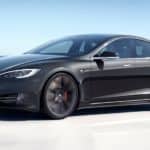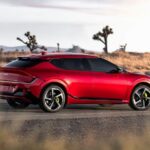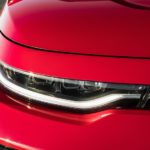Kia laid out a vision in 2021 of its path to becoming an electric vehicle superpower with seven new dedicated all-electric cars and SUVs by 2027. These dedicated electric models wouldn’t be based on existing models or platforms but would be designed from the ground up as electric vehicles. The clear goal was to challenge the reigning king of electric cars, Tesla, for its throne, and the Kia EV6 is the first fruit of this new electric crop.
If you’re shopping for exciting EVs for sale, how does the EV6 stack up against the Tesla Model 3, which is a close match to the new Kia in size and price? Does the Kia have what it takes to knock the Model 3 from the EV throne? How do these two models compare in price, range, and performance? To keep the comparison to similarly optioned and comparably priced models, we’ll look at the Kia EV6 GT and the Tesla Model 3 Performance.
Both vehicles have very similar overall lengths, with the Kia reaching 4,680 mm and the Tesla measuring just a bit longer than that at 4,694 mm, making them near-equals from bow to stern. However, the Kia’s height of 1,545 mm tops its competitor’s 1,443 mm, and it has an extra 15 mm of ground clearance. The EV6 GT is also noticeably heavier at 2,175 kg against the 1,836 kg of the Model 3 Performance.
In terms of configuration, the Kia EV6 is a hatchback, while the Tesla Model 3 is a sedan. This means the Kia has one extra door in the form of its rear hatch. While the two cars are similar in size but different in layout, they share many other qualities, right down to their upgraded, performance-oriented all-wheel drive powertrains.
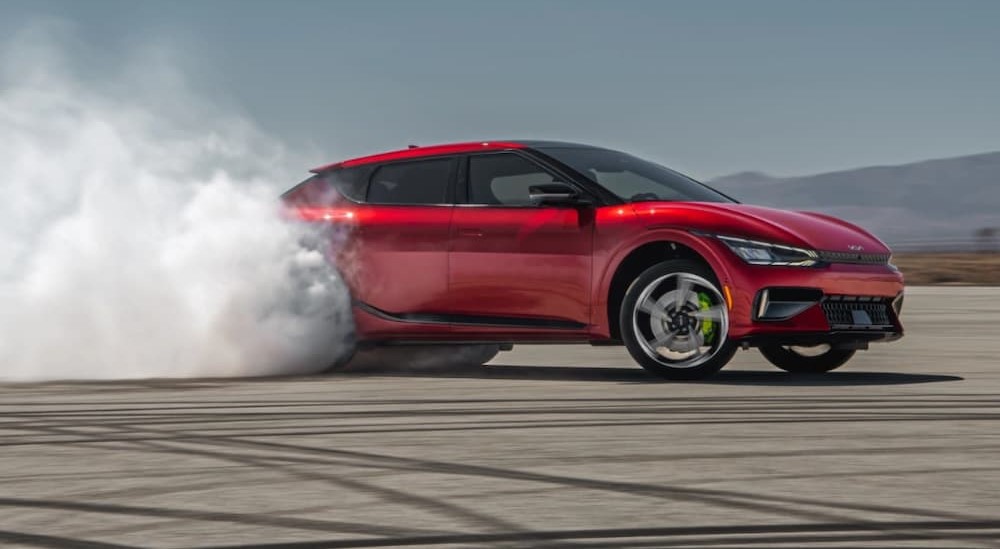
Meet the Kia EV6 GT
The Kia EV6 GT is built on the foundation of Kia’s advanced Electric-Global Modular Platform (E-GMP). This platform is central to Kia’s electric ambitions, setting the stage for segment-defining performance and efficiency. The E-GMP platform has been designed from the ground up to suit the needs of electric vehicles rather than trying to retrofit an existing internal combustion-powered platform with an electric powertrain.
The EV6 GT distinguishes itself not only as another electric vehicle but also as a high-performance tourer. The all-wheel drive GT powertrain boasts significant advancements over the standard EV6 all-wheel drive models. Most notably, upgraded motors translate to an 80% increase in total power output over the all-wheel drive Wind and GT-Line trims. With 576 hp and 545 lb-ft of torque, the EV6 GT has plenty of get up and go.
Apart from the powertrain, the EV6 GT also offers superior ride and handling features. These include performance brakes and a meticulously engineered suspension. Additional GT Mode and My Drive Mode options in the Drive Mode Select system further allow drivers to fine-tune their driving experience, catering to both spirited drives and relaxed cruises.
Performance and Elegance
The EV6 GT’s exterior design, though, is where it truly communicates its dual identity of performance and elegance. Kia refers to the design language of its aggressively squinting LED headlights and snarling grille as its “Digital Tiger Face.” Flared fenders and a flowing character line that sweeps upward from the rocker panel sills to the integrated ducktail spoiler complete the EV6 GT’s muscular stance. The front bumper is unique to the GT trim to set it apart from the base EV6.
If it’s possible to be a fastback SUV, the EV6 pulls it off. There’s no mistaking that it’s a crossover, but its roofline slopes downward toward the rear hatch to give it a slick, aerodynamic profile. The GT trim wears unique 53 cm alloy wheels that reveal neon green brake callipers. The rear bumper is also unique to the GT edition, completing the upgraded styling from front to back.
Suede-trimmed bucket seats are standard in the GT trim. Accented with metal “GT” inscriptions and neon green piping, the seats exhibit the EV6 GT’s high-tech flair. The cabin boasts premium finishes highlighted by a striped motif on some surfaces. Ambient mood lighting enriches nighttime drives. Additionally, twin 31 cm infotainment displays control most of the car’s tech-oriented features.
Kia’s advanced 800V fast charging system can restore up to 100 km of range in only four and a half minutes. You can also go from 10% to 80% charge in only 18 minutes. Of note, the EV6 uses an efficient heat pump rather than resistive heating to warm the cabin and battery pack. This helps to increase winter driving range by reducing the energy used by climate control on cold days. The 2024 Kia EV6 model range begins at $59,066 CAD, but to get into the top-of-the-line GT trim will run you $79,566 CAD.
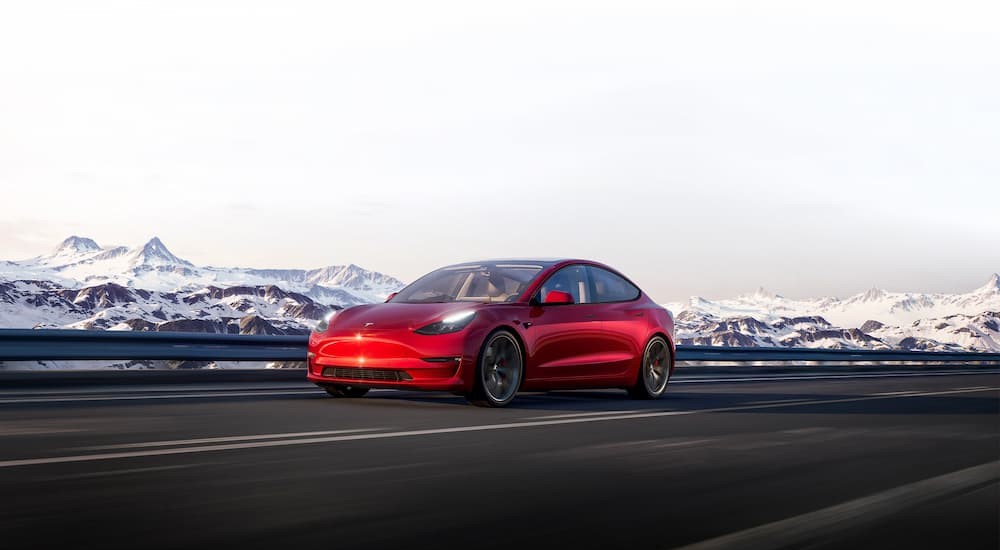
Meet the Tesla Model 3 Performance
By comparison, the 2024 Tesla Model 3 Performance costs a bit less than the Kia at $73,290 CAD. Tesla prices have been reduced dramatically over the past year as Tesla adjusts to a changing and more competitive EV marketplace. Note that neither the Kia EV6 GT nor the Tesla Model 3 Performance is eligible for a federal iZEV rebate because they cost over $65,000 CAD. However, the lower trims of both vehicles are eligible.
Like the Kia EV6 GT, the Model 3 Performance sets itself apart with an upgraded dual-motor setup for electric all-wheel drive. Although Tesla does not publish horsepower figures for the Model 3, it is estimated that this configuration yields somewhere over 500 hp. Despite this spirited performance, efficiency is not compromised, as we’ll see in the head-to-head comparison later.
Beyond performance, the Model 3’s design ensures practicality for everyday use. The vehicle comfortably seats five passengers and, thanks to its innovative design, which places the battery beneath the floor, it doesn’t skimp on legroom. The Model 3 also has plenty of room for cargo, providing 649 litres of cargo volume between the trunk in the back and the “frunk” in front. However, it’s worth noting that the Model 3’s fastback silhouette shouldn’t be mistaken for that of a hatchback, and it can’t accommodate oversized items as easily as the EV6.
The interior design philosophy of the Model 3 revolves around minimalism, dominated by a substantial 38 cm touchscreen. This central display streamlines the cabin by consolidating the HVAC controls, infotainment functions, and the instrument cluster into a singular interface. While Tesla fans rave about the clean design, many drivers prefer a more traditional layout like you will find in the EV6.
With approximately 1,500 Tesla Superchargers spread across Canada, the Model 3 Performance can be conveniently charged on the go. These Superchargers are designed for ease of use, allowing drivers to recharge without the hassle of a credit card and delivering up to 242 km of range in just 15 minutes. For those charging at home, a Level 2 wall charger can fill the Model 3’s battery from empty in about eight hours.
No Tesla review can fail to mention one of Tesla’s most cutting-edge (and controversial) features: what it calls Full Self-Driving Capability. Tesla claims this can drive you almost anywhere with minimal driver intervention. It includes Basic Autopilot, Enhanced Autopilot, Autosteer, and Traffic Light and Stop Sign Control. You’ve probably seen the videos of Tesla drivers asleep at the wheel or climbing into the back seat while “self-driving.” Don’t do that. Please. But if you use it as intended, it can be a very useful electronic copilot. You will have to pay an extra $16,000 CAD to have Tesla activate this feature, though.
Head to Head
The size, layout, and technology of both cars are very similar. How do they fare in a matchup on the road? Well, with electric vehicles, you always want to know one big number first: the range. The 2023 Kia EV6 GT delivers an estimated range of 332 km, which is noticeably less than lower-spec models of the EV6 and reflects its performance-oriented tuning. By comparison, Tesla claims 507 km of range for the 2023 Model 3 Performance.
How about actual performance? The EV6 GT can launch from 0-100 km/h in only 3.5 seconds and has a top speed of 260 km/h. Very impressive, but Tesla actually ekes out an extra 0.2 seconds with a 3.3 second 0-100 km/h run. Tesla’s website doesn’t list a top speed for this model. Perhaps they don’t want to encourage people to sleep in the back seat at top speed.
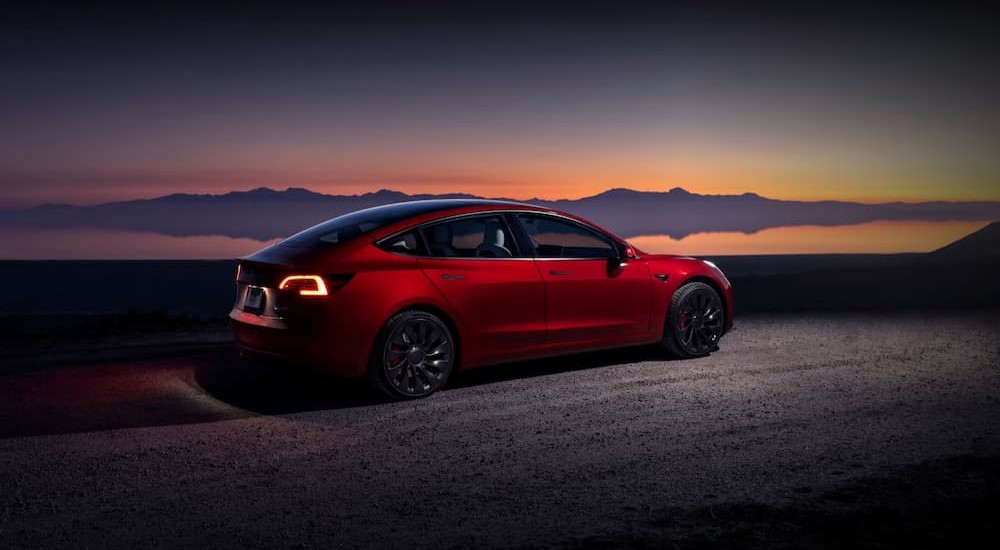
The Verdict
This one is a tough call. The Tesla has a noticeable edge in range and a very small edge in acceleration. However, the Kia is a newer design with a more luxurious cabin and faster charging. Plus, Kia offers a five-year or 100,000 km comprehensive warranty and an eight-year or 160,000 km warranty on EV components. Tesla’s basic vehicle warranty is only four years or 80,000 km, but its warranty on the battery and drive unit components goes all the way to eight years or 192,000 km for the Model 3 Performance.
Perhaps the warranties reflect a basic truth: Kia is backed by the massive resources of the Hyundai Motor Group, so it can offer a better overall warranty. However, Tesla has more experience with electric motors, so it feels confident in offering a long warranty on those components.
Another warranty-related consideration: Kia dealerships and service centers are everywhere. As such, the Kia may appeal more to drivers who want the confidence of owning a mainstream vehicle, while the Tesla is for more tech-oriented types who don’t mind a bit of inconvenience at times. If both vehicles make your pulse race, the easy availability of Kia service centers might be your deciding factor.
Ultimately, the choice between the Kia EV6 and the Tesla Model 3 comes down largely to your personal preferences. In a way, this is great news. It provides extra evidence that the age of electric cars has advanced beyond the “soulless appliance” stereotype and reached the point where there are EVs to suit every personality.
